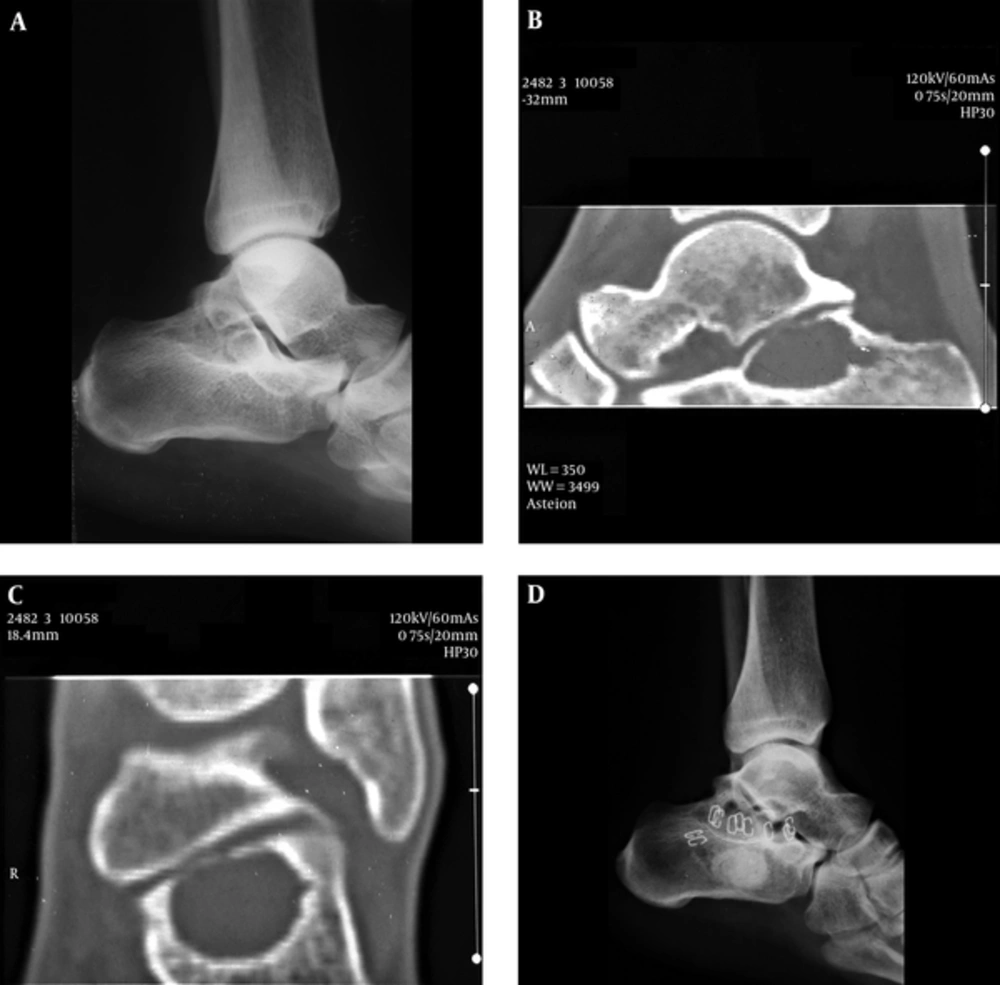1. Introduction
Chronic unremitting pain in the lower limb is sometimes a diagnostic dilemma for the physicians. The primary rare etiology is easily overlooked in the initial evaluation. There have been case reports of people with chronic lower limb (1) and foot pain (2) who were diagnosed late because the initial evaluation did not include the rare causes they suffered from. We, here, report a military soldier with ankle pain who actually had calcaneal cyst and was treated wrongly as a case of ankle sprain for six months.
Calcaneal cysts are benign or unicameral bone cysts (UBC) seen radiographically as single thin-walled lytic bone lesions without surrounding periosteal reaction. UBC are common in humerus, femur, and tibia but quite uncommon in the calcaneus (3). Calcaneal cysts generally remain asymptomatic in most patients and are discovered incidentally but in some, they may cause localized bone pain that is progressive in intensity. If not picked on the conventional radiographs, the diagnosis is delayed and the patient remains distressed and dispirited especially if he or she is a walking worker. This report highlights the importance of a detailed evaluation in a case of chronic unrelieved ankle pain and the importance of advanced imaging techniques if conventional imaging fails to pick the etiology.
2. Case Presentation
A 22-year-old otherwise healthy male soldier was referred to an orthopedic surgeon for the evaluation of chronic unremitting pain in right ankle that had been troubling him for the past six months. The patient graded the pain as 6/10 on Numeric Rating Scale. The pain aggravated on walking and running and was relieved on taking rest. There was no history of trauma or any joint disorder in the past. His family history was negative for any inflammatory joint disorder. The orthopedic surgeon ordered radiographs of the affected ankle and foot that were read as negative for any fracture, dislocation, or a space occupying lesion by the radiologist (Figure 1A). His lab investigations including complete blood count, erythrocyte sedimentation rate, C-reactive protein, and serum uric acid levels were all within normal limits. He was labelled as having ankle sprain and was suspected a malingerer. Thereafter, he was referred to our department for physiotherapy.
In our department, we examined him again. He had no swelling but tenderness over the calcaneus with reduced ankle inversion to 20° and eversion to 5°. Ankle plantarflexion and dorsiflexion were normal and there was no neurological deficit.
Keeping high sympathy for the patient, a computerized tomography scan of the ankle was requested that demonstrated a calcaneal cyst (Figure 1B and C). The patient was then referred back to the orthopedic surgeon for surgical intervention.
The orthopedic surgeon did surgical curettage followed by bone cement filling (Figure 1D). The range of motion exercises were continued and at 10 months’ post-surgical follow up, he got rid of pain, however, the ankle eversion was minimally restricted (10°). Written informed consent was taken from the patient for the publication of this case report.
3. Discussion
Several theories have been postulated to explain the origin of UBC, including trauma and inflammation, however, none has been conclusive (4). Calcaneal cysts are usually asymptomatic, but may present as progressively mounting bony pain with increased local skin temperature (5). A bony swelling may be palpable and movement in the adjacent joint may be affected (5). Active treatment of calcaneal cysts is recommended because the outcome is more favorable than the conservative management. There are chances of calcaneal fracture and collapse (6). Among active options, the healing rate was found to be similar with steroids or bone marrow injection but a higher rate of healing was reported when demineralized bone matrix was added (7). The surgical options are flexible intramedullary nails without curettage (7) and curettage followed by utilization of allograft, autograft, or bone cement producing healing rate approaching 90% (7, 8). Healing rate is also high with the utilization of intramedullary nails (7). The emerging treatment methods that are used as adjuvants or alternative therapies with varying success rates are Argon beam coagulation, sclerotherapy, radiotherapy, arterial embolization, and medical management with bisphosphonates or denosumab (9, 10). The alternative therapies are primarily reserved for inoperable lesions or lesion at anatomic locations where surgery may cause significant morbidity (9).
In conclusion, this report endorses the long-heard aphorism “the patient is mostly right”. Thinking out of the box and raising a high suspicion of an alternative diagnosis is recommended in all cases where usual management is not beneficial in commonly expected pathologies.
